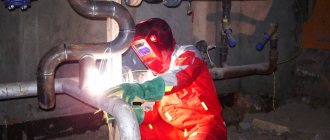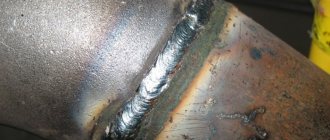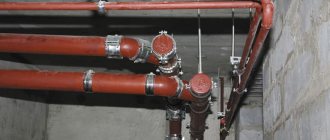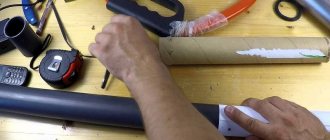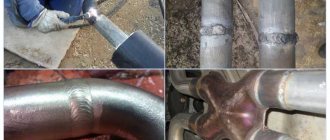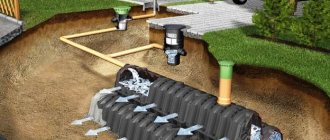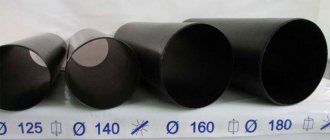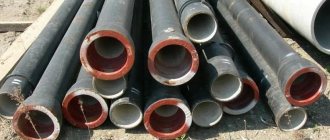One of the main tasks that determines the quality of a pipeline made from pipes with PPU insulation is the correct installation of joints. Such products are sold with non-insulated sections on both sides, which is necessary for ease of connection. If all work is carried out correctly, the pipeline will be reliably protected from aggressive environmental influences and will demonstrate maximum service life.
The operation of the entire pipeline depends on the quality of sealing of pipe joints in polyurethane foam.
Conditions of work.
2.1. Insulation of the joints of polyurethane foam pipes begins after 100% inspection of the welds of the joints using a non-destructive method or after a hydraulic test of the pipeline.
2.2.. Work on insulating joints is carried out at an air temperature of at least -15 C°, as well as in the presence of technological pits of at least 1.4 m (0.7 m in each direction from the joint) and a depth of at least 400 mm, according to VSN 11-94 , VSN 29-95 and SP 41-105-2002
2.3. During precipitation (rain, snow), work is carried out only under temporary cover, which prevents moisture from entering the mounted elements.
2.4. When installing a heating main equipped with a system for online remote monitoring of the insulation condition (ODC), immediately before performing work on insulating the joint, it is necessary to connect the signal conductors and carry out control measurements in accordance with the “Instructions for connecting signal conductors” and “Instructions for carrying out control measurements”.
2.5. On pipelines with a steel pipe diameter of 273 mm and above, heat shrinkage of couplings is carried out using two gas burners simultaneously.
Joint sealing methods
The method of installing PPU joints depends on:
- heating main construction method (underground, above-ground, ducted and ductless);
- estimated service life;
- working pressure;
- working environment temperature;
- external insulating coating.
Types of sealing of PPU joints:
- coupling;
- shell;
- pouring.
Coupled
The method is used when sealing joints of polyurethane foam pipes in critical systems. In addition, couplings are used in pipelines with labor-intensive construction and aggressive operating conditions. These include systems built underground without channels.
The coupling is a cylindrical heat-shrinkable sleeve. The material for the part is radiation cross-linked polyethylene.
The cuffs have a slightly larger diameter than the pipes, and when heated, they tightly grip the joint section of the pipeline. After heat treatment, liquid polyurethane is poured into the space under the coupling. After this, the hole for supplying the composition is sealed.
Shell
“Shell” – polyurethane half-cylinders. The products are fixed on the pipes with bandages or mastics and polyurethane is fed into the resulting mold. After this, the joint is sealed with adhesive polyvinyl chloride tape, subjecting it to heat.
The method allows you to evenly distribute the poured material. The shell is easy to install; its installation does not require lengthy preparation. The elements are produced in different thicknesses, including reinforced ones that can withstand extremely low temperatures.
Shell sealing is used for above-ground and underground ductless construction of heating pipelines.
Filling
The method is used with pipelines laid by underground channel, non-channel or above-ground routes.
Pouring involves the use of a galvanized steel casing, rolled or regular. The PU foam mixture is fed into the holes between it and the pipe. The feed holes are closed with covers on self-tapping screws. The waterproofing layer is heat-shrinkable tape, which is fused to the casing by heating with a gas burner.
The poured insulation method is more reliable than the shell method, but is inferior in strength to the coupling method.
Materials
The main material for insulation is polyurethane foam, a type of plastic. 85-90% of PUF is occupied by gas formed into cells, the remaining 10-15% is their thin walls. The insulation is poured in a thin layer sufficient for low thermal conductivity. Other material properties include:
- moisture resistance;
- impact resistance;
- light weight;
- immunity to decay and microorganisms;
- resistance to mechanical damage.
Polyurethane foam is created on the work site by mixing two liquids - polyol and polyisocyanate.
The shells are made from polyurethane foam. The surface of the products is smooth, the shape is precisely adjusted to the geometry of the pipe. Placed underground, the insulation does not absorb moisture and does not lose its thermal insulation qualities. Manufactured in accordance with GOST 30732-2001, the coating can withstand temperatures from -180 °C to +130 °C, and for a short time - up to +150 °C. The two shells are connected by a tongue-and-groove lock, which prevents cold from penetrating into the joint.
The couplings are made of radiation cross-linked polyethylene, resistant to corrosion, water, vapors, gases, acidic and alkaline environments. The material shrinks as the temperature increases, shrinking to almost the size of a pipe. The regulatory document is state standard 30732-2006. Thermal couplings operate at temperatures of -70 °C…+70 °C.
The material for the cast insulation casing is galvanized steel. Galvanization protects the body from corrosion damage. The product has the form of a rolled pipe made of thin sheet metal with a thickness of 18-40 microns. Steel parts are produced to match the geometry of straight pipeline sections, transitions, bends, and tees. The parameters of the casing are regulated by GOST 30732-2006.
Carrying out installation of PPU pipe joints
Applying a heat-shrinkable sleeve is the main step in carrying out good thermal insulation. Insulation of joints on already installed polyurethane foam pipes is carried out in the following sequence:
- The ends of the thermal insulation are cleaned, and the surface of the galvanized or polyethylene shell is cleaned from dirt with a brush; if necessary, washed, and then dried with an atmospheric burner. This stage is necessary in order to move the shrink sleeve over an absolutely clean surface. Clean the surface at a distance no less than the length of the prepared coupling. If there are any formations or corrosion on the inner steel pipe, they should be cleaned off with an iron brush.
- The insulating layer under the shell must be cleaned to a depth of 15-20 mm for protection. The remote control wires are connected, control measurements are carried out according to the appropriate instructions.
- The surface of the polyethylene shell is degreased on both sides of the joint. The surface should be treated with solvent at a distance of 150-200 mm from the edge. After the first treatment with a solvent, polymer ethylene is sanded and then finished again.
- Next, mark the position of the coupling along the axis of the joint. Using a white permanent marker, marks are applied to the surface that match the edges of the coupling. The prepared, cleaned and degreased surfaces should extend 20-50 mm beyond the possible edges of the coupling. Chalk is not allowed to be used for marking.
- The heat-shrinkable sleeve is unpacked in such a way that the outer part of the packaging film is located on the surface of the PPU pipe shell. No substances must come into contact with the inside of the coupling. If liquid or dirt gets on the coupling, its internal part is degreased, cleaned and degreased again.
- A hole with a diameter of 25 mm is drilled at a distance of 150 mm from any edge of the coupling.
- The surfaces of the shells at the joint, prepared for insulation, are heated with a propane torch to a temperature of +30-50 degrees. While the surface remains warm, a flexible mastic tape is glued to it with a distance of 10-15 mm from the edges. Once you are sure that the adhesive tape is firmly attached, you can remove the protective film from it. Dust and dirt particles are not allowed to enter an unprotected tape.
- The coupling is put on the pipeline section in accordance with the set marks. The edges shrink when heated with a burner: heat should be done in a circular, light motion. The coupling should not be allowed to overheat; this is indicated by the appearance of a shine on the surface. With proper shrinkage, the coupling will follow the contour of the shell, the surfaces will adjoin tightly, without raising the edges. The shape of the finished coupling is barrel-shaped.
- After the couplings have cooled, pressure testing is carried out, providing additional tightness.
Working with a heat-shrinkable sleeve requires heating the polymer ethylene to a sufficient temperature; this procedure is performed with an atmospheric torch
Important! If the ambient temperature at the time of work is less than 0 degrees, an atmospheric burner is passed at a distance of 30 cm from the surface of the shell to heat the polymer ethylene to a temperature of +30-50 degrees.
As a result of the tests, it is necessary to drill a second hole at a distance of 150 mm from the other end of the coupling. Liquid polyurethane foam, previously diluted from two elements in a clean container, will be poured into these holes. Upon completion of thermal insulation with foam, the holes are plugged with drainage plugs until the solution hardens.
The final phase of work on the insulation will be removing drainage plugs and cleaning the surface of the coupling from excess polyurethane foam. The holes are finished with a cone-shaped cutter. The holes are welded with polyethylene plugs at a temperature of +240 degrees.
The shell installation method is used if pouring is impossible for some reason. Their fixation is achieved using longitudinal or transverse locks. As a result of different types of insulation of joints, operation of the system is possible only if the integrity of the wires is successfully checked.
Installation of joint insulation
Diagram of insulation installation methods.
First you need to perform preparatory operations. Before welding the joint, you need to put a special coupling of the required diameter on one side of the pipe. In this case, actions must be performed very carefully so as not to damage the protective surface of the PU foam waterproofing. After this, the pipes are connected and welded.
After welding, the quality of the welds is checked. Then the remote control conductors are connected. Then they check the quality of the connection of the control system. After this, you can begin installation of thermal insulation of communication connections.
Methods for insulating transverse seams when joining pipes with an insulating coating
During the construction of pipelines, regardless of the type of insulating coating used, the most pressing problem remains the protection of the transverse weld, both from the inside and from the outside. The overall protection of the seam should not be inferior in its properties to the applied external and internal insulating coatings. The use of heat-shrinkable sleeves for external insulation of welded joints of pipeline pipes with an external 2- and 3-layer polyethylene coating is currently the most advanced technology when carrying out insulation work.
For these purposes, a whole range of heat-shrinkable insulating materials of the Tial brand has been developed. The originality of this system lies in the fact that it provides for the selection of material for any type of pipeline coating.
The advantages of the insulating coating “Tial” lie primarily in the possibility of their use in harsh climatic conditions, resistance to high soil loads and ultraviolet radiation, and chemical resistance to various reagents.
Thanks to the use of an epoxy primer, the use of the Tial material allows you to create both a two-layer and a three-layer coating.
When installing heat-shrinkable cuffs “Tial-M”, “wet” primer technology is used, which reduces the time for installing the cuff. Due to the unique adhesive (glue) layer, a high degree of adhesion and increased resistance to peeling are achieved.
"Tial" materials are supplied in convenient packaging and are ready for use: "Tial-M" cuffs have a length in accordance with the diameter of the pipeline, are equipped with "Tial-ZP" locking plates, the length of the locking plate is determined by the width of the "Tial-M" cuff and the tape " Tial-L." It is designed to “close” a measured piece of heat-shrinkable tape into a “ring” (around the welded pipe joint area). Tial-M cuffs are also equipped with a primer and a set of tools for applying insulation. Insulation of two joints is carried out as follows: applying a heat-shrinkable sleeve to the welded joint of two pipes; heat treatment of the applied cuff.
In this case, the cuff tightly covers the area of the welded joint, repeating the relief of the weld.
Heat-shrinkable materials “Tial”, depending on the purpose of application, are divided into the following types: “Tial-M” - heat-shrinkable sleeve for anti-corrosion protection of the weld of pre-insulated steel pipelines Ø 57-1420 mm. The top polyethylene radiation-chemically modified layer has the property of heat shrinkage; it is coated with a hot-melt adhesive layer made from a composition of ethylene copolymer with vinyl acetate, which has high adhesion and resistance to peeling; "Tial-L" is a heat-shrinkable tape for basic insulation of pipelines and anti-corrosion protection of bends, transitions, tees and other pipeline parts. The tape has a two-layer design (polyethylene base and hot-melt adhesive), which makes it possible to use it with a liquid primer, forming a three-layer anti-corrosion protection; insulation is produced by the spiral winding method.
"Tial-R", "Tial-Z" - repair materials for restoring damaged factory polyethylene coating of the pipeline. The Tial-R repair patch is a two-layer structure consisting of high-strength polyethylene and an adhesive layer - sevilene with a reinforcing fiberglass mesh fused into it.
Coatings based on heat-shrinkable tapes "Tial" have been tested for compliance with GOST R 1164-98, GOST R 51164-98, DIN 30672, and certified according to the international quality standard DIN EN ISO 9001: 2000-12. These coatings were chosen by OJSC NK Rosneft and TNK-BP as the main insulating material when implementing their projects in Russia. Work on the use of heat-shrinkable cuffs "Tial" can be carried out in highway conditions.
When assembling pipes for welding, it is necessary to use external centralizers. The tacks must be applied evenly along the perimeter of the joint after applying and drying the MK-5 slip on the edges to be joined from the inside of the pipe before joining (welding).
If the pipes have an internal silicate-enamel coating, then to ensure anti-corrosion protection of the welded joint from the inside, the pipes are assembled as follows: a slip (MK-5 enamel) is applied to the inner surface of the pipe; the applied slip must dry; the ends of the welded pipes are pressed against each other; chamfer welding is carried out in the usual way; under the influence of welding energy, an anti-corrosion coating is formed inside the pipe over the entire contact surface of the connected pipes.
Butt joint welding modes must ensure complete melting of the dried layer of enamel frit (MK-5 slip) previously applied to the inner surface of the pipes (end).
The proposed technologies for anti-corrosion protection of welded seams allow pipelines to operate durable and reliable.
Insulation of pipeline joints using bitumen-mastic and tape insulation
, bitumen mastics are mainly used of those brands from which the pipe coating is formed, in particular bitumen-rubber mastic (GOST 15836), bitumen-atactic mastic and bitumen-polymer mastics.
Before applying the primer, the insulated surface of the joints is cleaned of dirt, scale and rust to a metallic shine and wiped dry with rags or soft brushes. The primer is applied to a dry surface immediately after cleaning the pipeline. The primer layer should be even, without gaps, clots, smudges or bubbles. The mastic is applied hot at a temperature of at least 170° by pouring onto the surface from a watering can and rubbing from below with a towel. Wrapping pipe joints with brizol and kraft paper is done over hot bitumen, and wrapping pipe joints with adhesive tape is done without distortions and wrinkles; corrugations on the tape are not allowed. The overlap of the turns on each other is at least 2 cm. The internal winding layers are applied without overlap, while the gap between the turns is not allowed. 5 mm. When applying adhesive tape layer by layer, overlaps of adjacent layers are not allowed to coincide. The end of the winding is overlapped by the beginning of the next tape by at least 10 cm (and secured with hot mastic - when wrapping the pipe joints with brizol and kraft paper).
What are the OC polyurethane foam joint insulation kits suitable for?
1) Steel pipes PU OTs 2) Steel bends PU OTs 3) Steel tees PU OTs 4) Steel tees with vent ball valve PU OTs 5) Parallel steel tees OTs 6) Tee branches steel PU OTs 7) Tee branches steel with transition PU OTs Sliding supports 9) Fixed supports 10) End elements of PPU OC pipelines with looping of conductors 11) Transitions PPU OTs 12) Ball valves PPU OC 13) U-shaped elements of PPU OTs 14) Z-shaped elements of PPU 15) Bellows compensators PPU OTs 16) Ball valves with air vent PPU OTs
Sliding supports 9) Fixed supports 10) End elements of PPU OC pipelines with looping of conductors 11) Transitions PPU OTs 12) Ball valves PPU OC 13) U-shaped elements of PPU OTs 14) Z-shaped elements of PPU 15) Bellows compensators PPU OTs 16) Ball valves with air vent PPU OTs
Types of insulation of pipe connection sections made of polyurethane foam
Finishing of pipe joints made of polyurethane foam with an insulating layer is done by filling the entire volume of the joint area with polyurethane foam in liquid form. You can also use special couplings (see Electrocouplings for pipes) made of polyurethane foam or shell. To insulate the joints of pipes made of polyurethane foam, a material such as polyurethane foam was chosen because, given its small thickness, it has very low thermal conductivity. In the past, when using such pipelines, the heat-insulating material was constantly moistened, which led to significant heat losses to the environment. The use of such a modern insulator as a polyurethane foam shell has made it possible to significantly reduce such heat losses through pipe joints.
The advantages of using polyurethane foam shell as an insulator are:
- such shells can be used in northern regions with very cold winters. The maximum temperature withstandable by polyurethane foam is minus 1300C;
- such thermal insulation material is reliably resistant to moisture;
- in the form of a shell, such material is also highly resistant to various mechanical influences on the joint.
One of the important points when designing pipeline systems is the correct selection of reliable and high-quality components for effective insulation of polyurethane foam connections. In order to increase the service life of connected pipe systems, it is necessary to reliably seal all joints. The use of a heat-shrinkable sleeve will allow you to insulate the connection of elements for a long time and without any losses. This method of compaction will ensure uniform insulation of the entire joint area according to the physical and mechanical characteristics of the insulating material.
We recommend: Shell for thermal insulation of pipelines made of PPU polyurethane foam
Quality control of the coating applied to the weld joint area
The formed protective coating satisfies the following requirements:
- has the same amount of overlap on the factory coating;
- copies the relief of the insulated surface of the welded joint without corrugations, wrinkles, extended and local air inclusions;
- has no punctures, burrs or other through defects;
- the thickness of the formed coating is at least 1.8 mm;
- the strength of the adhesive bond of the formed coating with metal and factory-made polyethylene coating is at least 3.5 kg per 1 cm of the width of the strip being peeled off.
Dimensions and specifications
| d, mm | D coupling, mm | coupling | Heat-shrinkable adhesive tape (applicator) | Drainage plug | Latka ots. 50x50 mm | Tinned copper sleeve | SODK support | Foam assembly package | ||
| L, mm | Quantity per joint | BхS, mm | Quantity per joint | |||||||
| 33,5 | 125 | 600 | 1 | 40x2.0 | 0,79 | 2 | 2 | 2 | 4 | 1 |
| 42,3 | 125 | 600 | 1 | 40x2.0 | 0,79 | 2 | 2 | 2 | 4 | 1 |
| 48 | 125 | 600 | 1 | 40x2.0 | 0,79 | 2 | 2 | 2 | 4 | 1 |
| 57 | 125 | 600 | 1 | 40x2.0 | 0,79 | 2 | 2 | 2 | 4 | 1 |
| 57 | 140 | 600 | 1 | 40x2.0 | 0,88 | 2 | 2 | 2 | 4 | 1 |
| 76 | 140 | 600 | 1 | 40x2.0 | 0,88 | 2 | 2 | 2 | 4 | 1 |
| 76 | 160 | 600 | 1 | 40x2.0 | 1,01 | 2 | 2 | 2 | 4 | 1 |
| 89 | 160 | 600 | 1 | 40x2.0 | 1,01 | 2 | 2 | 2 | 4 | 1 |
| 89 | 180 | 600 | 1 | 40x2.0 | 1,13 | 2 | 2 | 2 | 4 | 1 |
| 108 | 180 | 600 | 1 | 40x2.0 | 1,13 | 2 | 2 | 2 | 4 | 1 |
| 108 | 200 | 600 | 1 | 40x2.0 | 1,26 | 2 | 2 | 2 | 4 | 1 |
| 133 | 225 | 600 | 1 | 40x2.0 | 1,41 | 2 | 2 | 2 | 4 | 1 |
| 133 | 250 | 600 | 1 | 40x2.0 | 1,57 | 2 | 2 | 2 | 4 | 1 |
| 159 | 250 | 600 | 1 | 40x2.0 | 1,57 | 2 | 2 | 2 | 4 | 1 |
| 159 | 280 | 600 | 1 | 40x2.0 | 1,76 | 2 | 2 | 2 | 4 | 1 |
| 219 | 315 | 600 | 1 | 40x2.0 | 1,98 | 2 | 2 | 2 | 4 | 1 |
| 219 | 355 | 600 | 1 | 40x2.0 | 2,23 | 2 | 2 | 2 | 4 | 1 |
| 273 | 400 | 700 | 1 | 50x2.0 | 2,51 | 2 | 2 | 2 | 4 | 1 |
| 273 | 450 | 700 | 1 | 50x2.0 | 2,83 | 2 | 2 | 2 | 4 | 1 |
| 325 | 450 | 700 | 1 | 50x2.0 | 2,83 | 2 | 2 | 2 | 4 | 1 |
| 325 | 500 | 700 | 1 | 50x2.0 | 3,14 | 2 | 2 | 2 | 4 | 1 |
| 426 | 560 | 700 | 1 | 50x2.0 | 3,52 | 2 | 2 | 2 | 4 | 1 |
| 426 | 630 | 700 | 1 | 50x2.0 | 3,96 | 2 | 2 | 2 | 4 | 1 |
| 530 | 710 | 700 | 1 | 50x2.0 | 4,46 | 2 | 2 | 3 | 6 | 1 |
| 630 | 800 | 700 | 1 | 50x2.0 | 5,03 | 2 | 2 | 3 | 6 | 1 |
| 720 | 900 | 700 | 1 | 50x2.0 | 5,65 | 2 | 2 | 3 | 6 | 1 |
| 820 | 1000 | 700 | 1 | 50x2.0 | 6,28 | 2 | 2 | 3 | 6 | 1 |
| 1020 | 1200 | 700 | 1 | 50x2.0 | 7,54 | 2 | 2 | 3 | 6 | 1 |
| Polyurethane components are supplied in assembly foam packages equipped with a filler neck or a cutting spout. | ||||||||||

